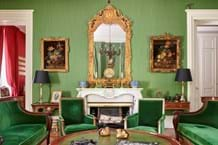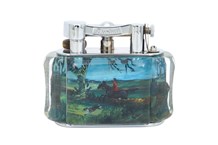Accordingly, competition was most intense for the best pieces of furniture, but prices were also strong for untouched, privately sourced material of mediocre quality. The need to buy outweighs the fear of being unable to sell. And with quality goods at a premium, increasingly vast amounts of money are being gambled on the slightly better chances of selling those goods.
The item which generated a disproportionate amount of interest at this sale was a Regency rosewood and parcel gilt breakfast table.
It’s slightly unusual features helped boost the bidding – in particular, the reeded flared pedestal and acanthus scrolled feet to the platform base, reminiscent of the flamboyant Regency designs by London cabinetmaker Thomas King, first published in 1829.
The 3ft 10in (1.18m) wide octagonal top rounded off a distinctive table and dealers loved the untouched, good condition of the parcel gilding to the reeded pedestal and acanthus feet. Estimated at £3000-5000, the table was bid on the telephone by two English dealers to a final price of £16,200.
In such a barren market, one would struggle to find another table like it. Likewise the George IV child’s mahogany elbow chair and table attributed to Gillows on the strength of a “near identical” archive design commissioned by Earl Cornwallis in the 1820s.
There are plenty of plain examples of this period, which can fetch about £500, but the auctioneer had not seen another with such reeding, scrolling and anthemion carving. Untouched condition also helped and dealers on the phone took it to a triple-estimate £4400.
Elsewhere there was a strong price for an early 19th century Georgian-style birchwood floor standing corner cupboard. Its vernacular quality resulted in an estimate of £500-800, but small size, 6ft 3in (1.92m) high, good colour and an agreeable match of astragal glazed upper and panelled lower sections all helped it to £2700.
The auctioneer was more disappointed by the response to a Victorian suite of furniture by Collier and Plucknett of Warwick and Leamington (1864-1880). The side cabinet, cabinet desk and writing desk were prefaced with an account of the partnership to drum up interest but the suite’s ebony veneers and Louis XIII Revival style represented the excesses of the Victorian period that the likes of James Plucknett escaped to join the Arts and Crafts movement. Such features remain deeply uncommercial.
The lavish ivory marquetry left no one in any doubt about the high quality of the suite, even if their price tags only reflected their unfashionable status.
The 2ft 7in (79cm) wide side cabinet made a lower-estimate £1050, the 2ft 6in (76cm) wide cabinet desk made £1100 – “given away in my view”, said auctioneer Mark Jones.
The writing desk was seriously distressed and sold at £100.
Other results among the furniture included a late George III bowfront chest on chest of two short and six long graduated, cockbeaded drawers divided by a brushing slide, 7ft high by 4ft wide by 22in deep (2.14 x 1.20m x 58cm), which made £4100, reflecting the damaged pediment and replaced handles.
A late 19th century set of eight ladderback mahogany dining chairs in the Chippendale style with tapestry drop in seats and chamfered block legs, including a pair of open scroll elbow chairs, made £3600. One of the more interesting items of furniture was a mahogany tripod occasional table, the 15in (37.5cm) diameter dished top unusually supported on three scrolled arms to a turned pedestal on three swept legs and pad feet. The table was catalogued as “late 18th century” with “alterations”, but the auctioneer offered no comment when questioned whether top and bottom of table had started life together.
However, the unusual format prompted speculative bidding from the trade, and a final hammer price of £3500 above the estimate of £500-800.
Outstanding entry among the works of art was a gravity-fed table fountain of the Edwardian period, fashioned from heavy cut glass in a gilt metal frame. The fountain was limpid and the glass was chipped, but the attribution to F & C Osler, crystal manufacturers to ‘Royalty and the Raj’, and a provenance to London dealers Mallett, more than compensated for these flaws, the 19in by 11in (49 x 28.5cm) fountain selling at £3100.
Phillips, Knowle, October 3
Number of lots offered: 387
Lots sold: 77 per cent
Sale total: £230,244
Buyer’s premium: 15/10 per cent
Scarcity of quality pushes Regency table to £16,200
WHILE it was worrying that Phillips’ main Midlands saleroom could find only 100 furniture lots worthy of their main autumn sale, and that only five of those took more than £3000, such is the drought of quality goods in the provinces at the moment that the trade were determined to make the best of any opportunity.




